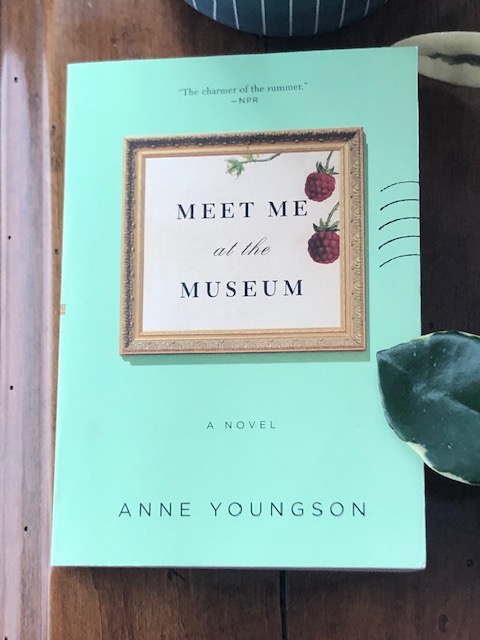
I have a fascination with novels in which the stories are told through letters written by one or more of their characters. These stories, fictional epistolaries, don’t easily translate to the screen so, with exception, they mostly sit quietly on library and bookstore shelves, waiting to be discovered.
Here’s a list of some of my favorites:
84 Charing Cross Road by Helen Hanff,
The Guernsey Literary and Potato Peel Pie Society by Mary Ann Schaffer and Annie Barrows,
The Historian by Elizabeth Kostova,
A Tale for the Time Being by Ruth Ozeki,
Vanessa and Her Sister by Priya Parmar,
Ella Minow Pea, by Mark Dunn, and
Gilead by Marilynne Robinson.
For me, reading an epistolary is like probing the minds of the individual characters. Their letters zero in on the circumstances, the places, and the times in which they live.
Meet Me at the Museum by Anne Youngson, is one of my new, favorite fictional epistolaries. It’s a contemporary novel entirely composed of letters between Tina Hopwood, a sixty-something farmer’s wife from rural England, and Anders Larsen, a recently widowed professor who is the curator of a Danish Museum.
The story begins when Tina, who feels ignored and undervalued by her husband and adult children, can’t remember choosing the life in which she now feels trapped. Questioning her own failure to pursue a girlhood fascination with Tollund Man, an Iron Age fossil (circa 250 B.C.) discovered in a Danish bog in the 1960’s, she writes a letter to the curator of the museum where the remains of Tollund Man are preserved. Although the person to whom she initially writes is, by then, deceased, the current curator, Anders Larsen, obliges her with a polite response, inviting her to visit the museum.
But when Tina answers his letter, she tells him that she has no desire to visit the museum, that the real reason she is writing, is “to make sense of myself”. The childhood friend with whom she shared her interest in Tollund Man has died and Tina wants to understand why she (Tina) never pursued this passion. She writes that she is not expecting a response but that she needs to be honest with herself and believes writing these letters will help her figure out some things about her life.
Anders, an urbane academic who deals only in facts and figures, responds again, discussing whether Tollund Man, whose neck was encircled by a rope when found, was the victim of a primitive ritual or was being punished for an offense against his community. Anders also shares that his wife recently passed away and, he mysteriously adds, he has no place to visit her remains. He asks Tina to continue to write because her letters are making him think.
Now also curious to learn the story of Anders’ wife, Tina writes again and Anders begins to open up about the details of his lonely personal life. Without giving away too much of the story, I’ll just say that over the next year, the pair relies on snail mail and eventually email (In my opinion, the story’s only disappointment), to exchange their stories, becoming more and more open with each other as they do. Because they are geographically insulated from one another as they pen their missives, each possesses the sense of security needed to share the disappointments and elations of their private lives. At one point, Tina writes, “If I destroyed the first half of this letter, it would be to disguise myself from you, and I do not want that, so I will send it.”
Through their letters, Tina and Anders better understand the choices they made during their lives. They also discover that, despite their vastly different backgrounds, they have much in common. When a dramatic and unexpected event befalls each of the correspondents, they find themselves relying on the bond they’ve developed through their letter writing to cope with their respective situations.
I think I was drawn to this little book because I’d previously read that, like me, the author of Meet Me at the Museum, began writing after she retired and this story, like some of my own writing, focused on the lives of people who, because of their age, were viewed by much of the world as neither having value nor being interesting. But I didn’t have to read far to see that the characters in this unique, understated work were very interesting. There’s an intelligence to Meet Me at the Museum, a richness that’s revealed as these two people, well past the prime of their lives, continue to discover who they are and, in the process, realize that perhaps their own love stories are not entirely over.
This simple tale, well-told, captured not just my interest, but my heart. If you’re looking for a quiet, thoughtful book and you, too, appreciate a good epistolary, I recommend Meet Me at the Museum.
Do you have any favorite epistolaries? If so, I’d love to know what they are. Write to me or email me at marilyn@leelanauletterwriters.org. (Some day I’ll figure out how you can add comments to my blog posts.) In the meantime, happy reading and, of course, letter writing!
Oh– and copies of Meet Me at the Museum are currently in stock and available at Bay Books in Suttons Bay.

